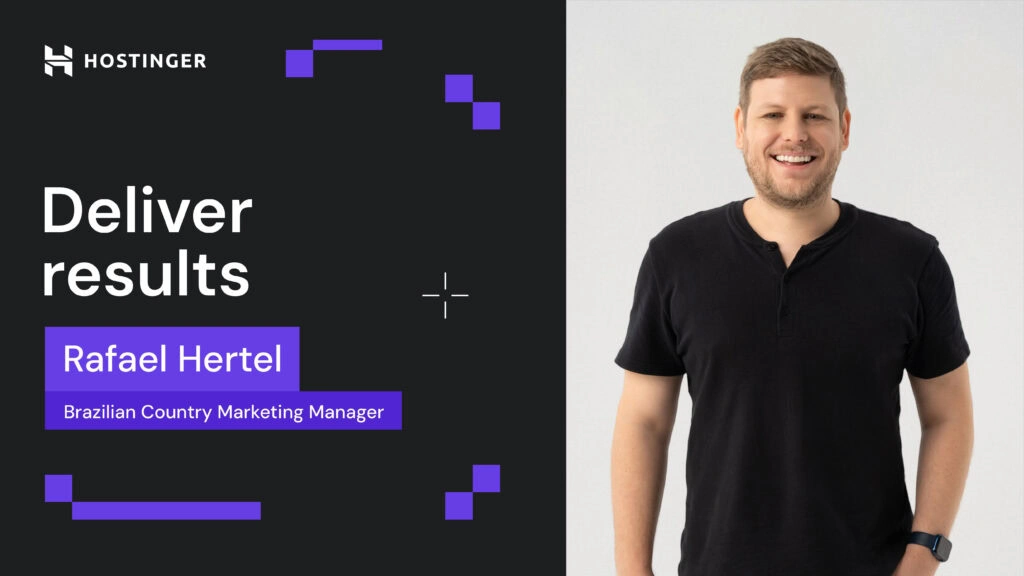The Science of High Performance: What Unites Top Talent

You’ve probably heard a thousand times that having a competitive advantage is essential for business success. But can an individual’s mindset and ways of working be a competitive advantage to your business?
I would argue that it is the power of the talent management process and the scarce resource that it provides – high performers – that can help turn your business around.
In this article, based on my speech at Lithuania’s biggest tech conference, Login, I want to share some of our ways of working and the mindset that made Hostinger successful. I believe you can easily apply them to any company or team, regardless of size or field.
You Can’t Play in a Professional League With Amateur Players
We have always been quite strict on only hiring according to our company principles. Early on, we understood that we, as a team, could not play in a world-class league with amateur players. To compete, we needed professional players.
But we noticed that it’s not just the technical skill set and experience that set professionals apart – there was something else when it came to high performers.
To scale and improve our talent management process, I began conducting internal research and interviewed our outstanding employees. And I discovered that certain individual traits were prominent across the board.
1. Ambition
For top performers, one of the most significant internal motivational attributes was ambition.
Most of the high performers demonstrated a continuous need to undertake and accomplish demanding tasks. Because of their ambition, employees show more proactiveness, enthusiasm, and persistence in their daily work.
Ambition connects two motivational needs: achievement and power. Striving for power can manifest itself through aiming for high positions in their careers, as well as influencing or impacting others around them.
It’s important to note that these two motivational needs should go hand in hand, and striving for power without striving for achievement can appear as a desire for a certain title without actual high performance.
If, during the hiring process, you’re looking for this trait, check the candidate’s CV for fast internal growth within a company. Ask about their biggest achievements and what they want from their future. This should give you a snapshot of how ambitious the candidate is.
2. High Expectations of Colleagues
It’s probably obvious that high performers have high expectations of themselves, mostly because of their ambition. But interestingly, the research also demonstrated that they have high expectations of others.
We found that colleagues who do not express the same level of motivation and performance demotivate the top players. High performers strive for achievement and don’t like it when others put in less effort than they do. They are irritated by the lack of quality and persistence. Also, it’s hard to learn from people who demonstrate lower performance.
Working in a team has two objectives: maintaining collaboration and achieving results. Depending on the situation, people must choose to “get along” or “get ahead”. Getting along means cooperating and seeking approval, where maintaining relationships is a priority. Getting ahead, on the other hand, is all about taking the initiative, competing, and seeking results. Normally, people try to balance between the two. However, one of these profiles tends to dominate.
In general, we found that the get-ahead type is more common among our high performers. However, both profiles can achieve high performance, especially when a person has other attributes related to top performers. It is important to remember that get-along type managers will be more likely to tolerate underperformance in their team, and team members might try to hide underperforming colleagues to save a collegial relationship.
During interviews, you can ask a candidate what they expect of their future colleagues. Most times, high expectations of others are closely related to high performance overall.
3. Seeing the Big Picture
The third trait that defines high performers is their ability to see the big picture.
In this context, it doesn’t mean one must understand business strategy well. It means that the task they’re doing should make sense to them. They don’t aim to just execute it but to clearly understand the why behind the job and how they contribute to the company’s success. Typically, high performers start their tasks by analyzing general information and only then move on to specific parts. In short, they want to see how the dots are connected.
According to literature, this type of performance process is typical for experts in their fields. However, many of the high performers I interviewed were still on their way to building their expertise. These findings suggest that there is a tendency for some people to build expertise quicker than others.
To check how candidates approach tasks and whether they have a big-picture mindset, you can ask them what they do differently or better than others when they are working.
4. Self-Efficacy, aka a “Can Do” Attitude
Self-efficacy is a trait that is always present in high performers.
Self-efficacy means self-belief in your ability to achieve what is needed – essentially, a can-do attitude. It creates an internal feeling that one is capable and that additional effort will grant success, often going hand in hand with the feeling of being in control.
But why is self-efficacy important for performance? Self-belief and feeling like you’re in control help individuals adjust better to different situations. It also improves focus, making it harder for external factors to take attention away from the desired result. It’s a trait that gives individuals willfulness, determination, and execution focus, helping them to not give up and constantly strive to improve in their roles.
Some people say that adaptability is one of the most important traits nowadays. However, we would argue that self-efficacy allows you to create a better strategy and learn faster in uncertain and changing situations.
This is backed up by science, too. Researchers conducted several experiments demonstrating how those with better self-efficacy could adjust their speed to reach the desired goal compared to those with lower self-efficacy.
In practice, this means that people with higher self-efficacy can easily navigate themselves in a fast-changing environment and cope with complexity and uncertainty. They usually enjoy difficult tasks and easily learn by simply doing. You can expect a junior fast-track their way to becoming a senior specialist if they have this trait.
To check if your candidate has a can-do attitude, ask them how they reacted when they were given an assignment that was very complex and unclear. Pay attention to how they performed and what the end result was.
Don’t Get Stuck With Underperformers
The truth is that most managers and HR specialists in every company are busy with underperformers. They focus on making performance improvement plans and having endless one-on-ones to see the tiniest signs of improvement. And at the same time, the other 20% of high performers silently do 80% of the work. That’s unfair.
I’m not saying you shouldn’t deal with underperformers at all. But I would like to suggest prioritizing differently. Your first and most important task as a manager, HR professional, or CEO is to not demotivate your high-performers. Instead, let them perform to their full potential.
Interested in joining us? Check out our job opportunities or connect with us on LinkedIn. Looking for more information about how to retain your top performers? Watch this space for more tech talent acquisition content.


